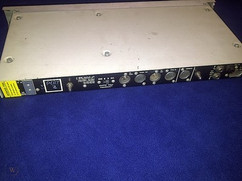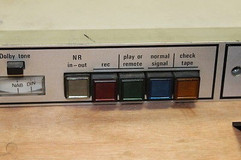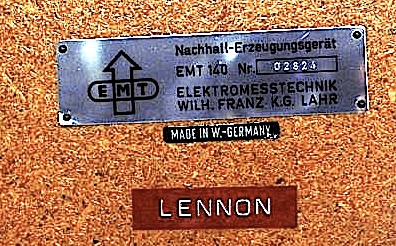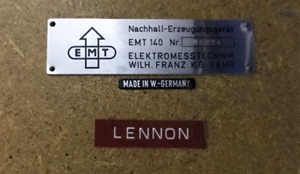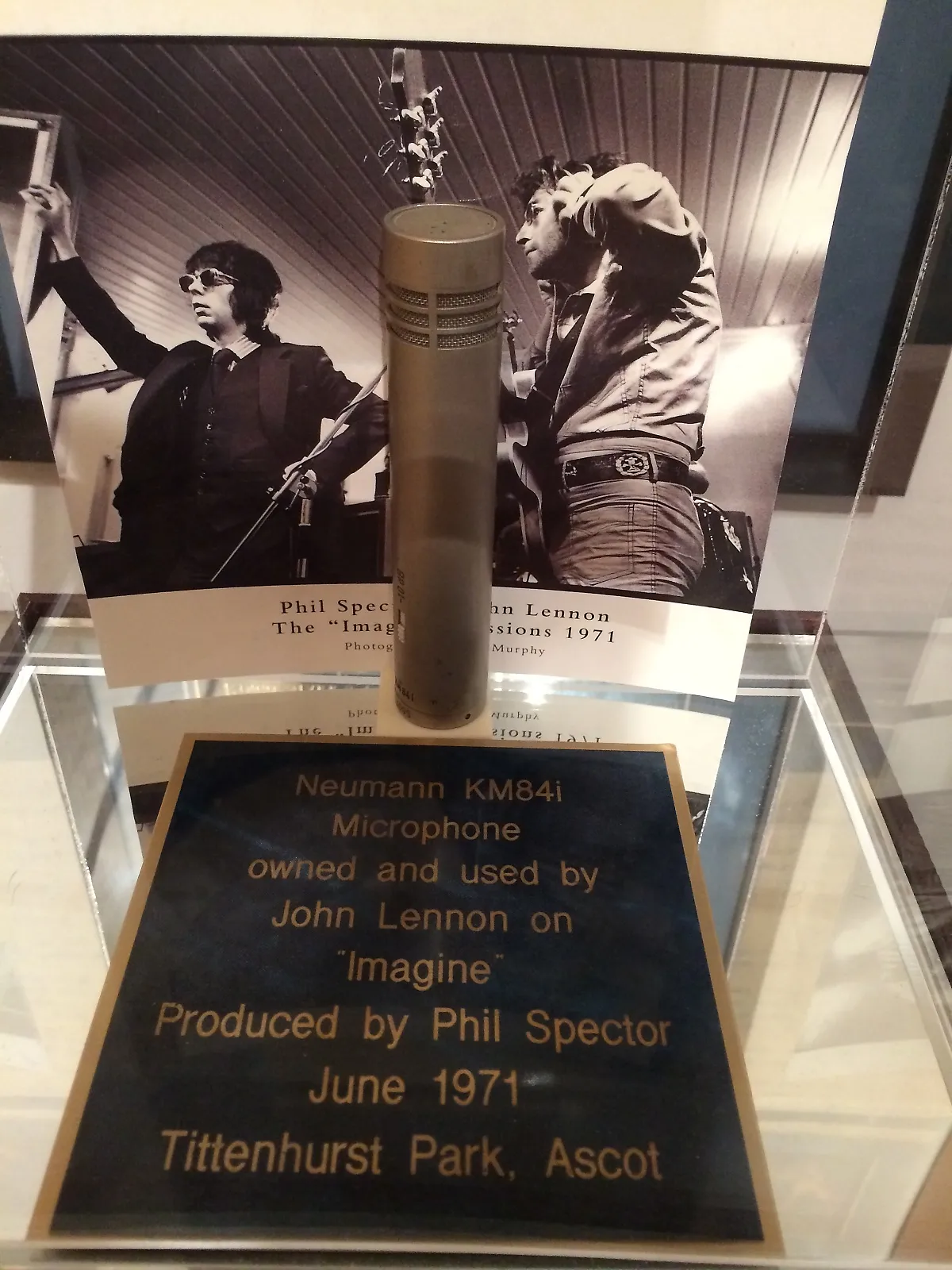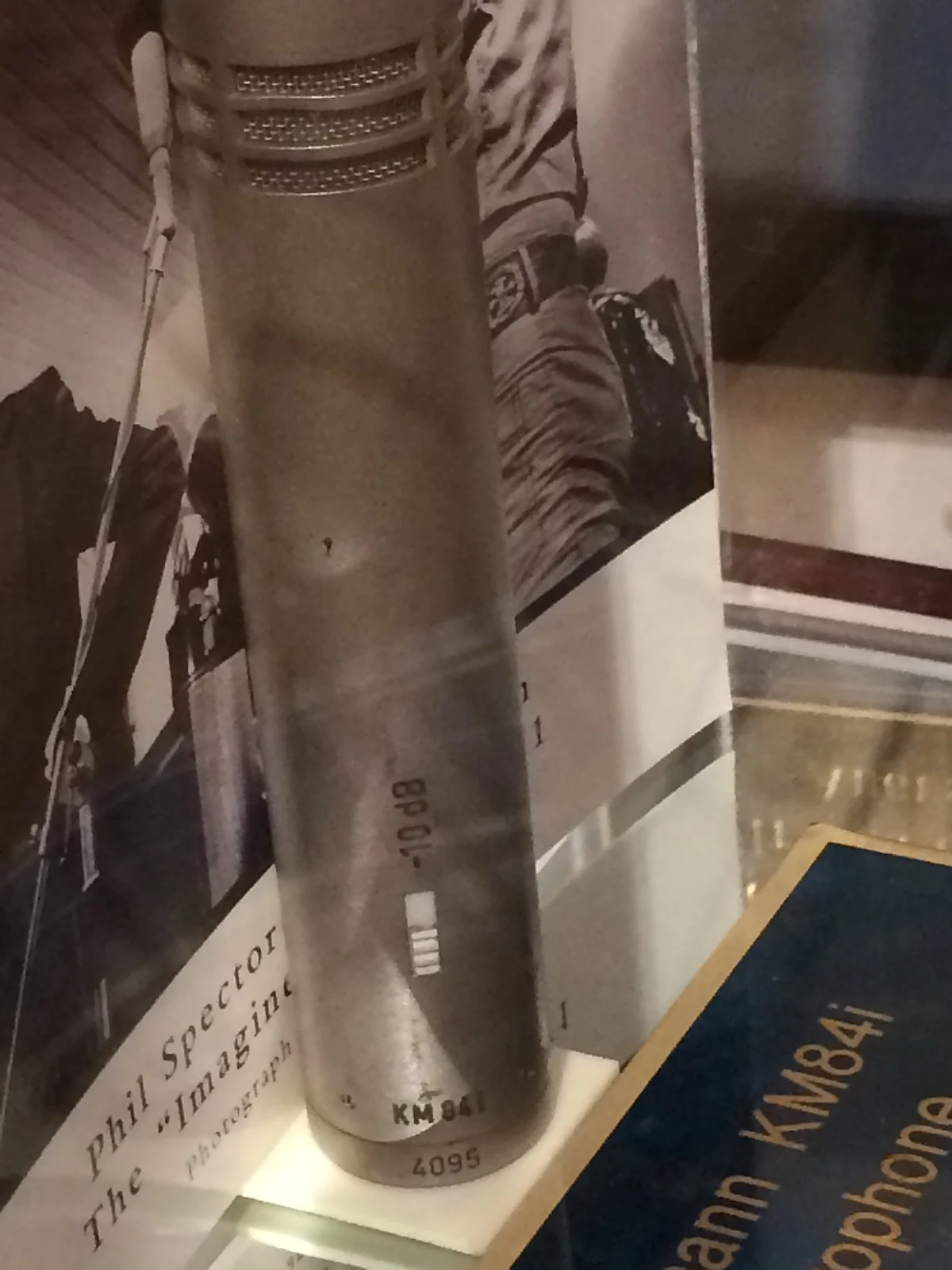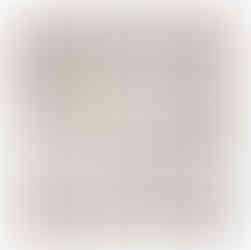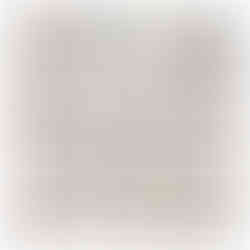Recording Equipment Of Ascot Sound Studios
- Solo Beatles Studios
- Feb 14, 2023
- 13 min read
Updated: Nov 17, 2023
3M M23 Tape Machine
1" Eight-Track. Purchased by John in 1968. The very earliest photos of Ascot Sound Studios show the M23 as the studio's sole multi track tape. The Beatles first used a M23 at EMI (Abbey Road) Studios in 1968 on "While My Guitar Gently Weeps" and would then go on to purchase three of their own M23s later that year. One of those machines, George's, would be used for the Let It Be sessions.
According to Recording the Beatles "George can be heard explaining to Glyn Johns [during the Let It Be sessions] that the group actually owned three eight-tracks: one was George's, which he had at his home; one was John's, which was at Apple Electronics in Boston Place; and a third machine, intended for use at Apple, also housed at Boston Place."
By the May 1971 Imagine sessions and possibly earlier, a 3m M56 was added to the studio and was being used as the multitrack for the sessions. Its unclear if the M23 had been used on the early February sessions at all or if it had already been replaced by the M56 at that time. Even when the M56 was being used, the M23 was at least powered on.


3M M56 Tape Machine
1" Eight-Track. From video of the Imagine sessions, it seems that a 3M M56 eight track was used as the multitrack deck on most or possibly all of Imagine. In the Imagine John and Yoko book, Eddie Veale mentions that the M56 was from Apple Studios. Ascot had a 3M M23 eight track, so its not clear why they brought in the M56 from Apple for the sessions.
It seems unlikely that it offered any significant sound or functionality upgrades to warrant bringing it in to replace the M23. Although the M56 was significantly smaller, pictures show that the M23 remained in the control room during the sessions, so it wasn't a size/space concern. Its possible they were having problems with the M23 and didn't have time to repair it and opted to just bring in the M56.

3M M64 Tape Machine
1/2" Four-Track. A M64 tape machine can be seen in the back of the control room, likely to be used for Quadraphonic mixes. Eddie Veale explains "Quad was the emerging thing at the time, so we hooked a couple of JBL speakers up at the back for them to play with."
It doesn't seem that much Quad work took place at Ascot perhaps beyond some minor experimentation. Apparently John wasn't originally sold on the idea, but by the time he was in New York in July to finish the album, he had been convinced saying "We recorded some in Quad too, it’s fantastic, I did the Quad in New York, it’s beautiful. Quad Music!"
Eventually, Quad mixes of Imagine were done in 1971 by Roy Cicala with John, Yoko, and Phil Spector at The Record Plant in New York City.

AKG microphones
Eddie Veale mentions "a few AKGs” being at Ascot. I have not been able to identify any in videos or photos though. The book Eight Arms to Hold You: The Solo Beatles Compendium has a partial gear list for Ascot Sound Studios which lists the AKG(s) as being a C452, a small diaphragm condenser and the successor to the more well known C451. That said, I take that list with a grain of salt as it also includes a few pieces of gear that didn't exist until several years later.
Amcron/Crown DC300 power amplifiers
The monitor speakers and the chamber speakers at Ascot, were powered by Amcron DC300 power amps. "Amcron" was the export brand name for Crown, and Veale refers to the amps in interviews as both "Crown" and "Amcron" DC300s.
Mix Magazine say of the DC300: "In many ways, the 1967 introduction of the AB+B-class DC 300 ushered in the era of the modern, high power amplifier. Offering 340 watts/channel (at 4 ohms), this 4-rackspace, 40-pound beast came in at less than the “magic” $1/watt price point, based on its original $685 retail. And with its rock-solid construction, and internal thermal and V-I protection modes, the DC 300 was the ideal solution for high-end consumers, high-SPL studio monitors and live sound systems coming into vogue with the summer of love." (source)
AmpliVox Astrolite Headphones
I believe the headphones at Ascot were some variation of AmpliVox Astrolites. I don't know much about Amplivox, but they seem to be a company that made headphones and other equipment primarily for the aviation, industrial, and broadcast industries. From what I've read online, Astrolites were fair sounding but certainly not exceptional headphones. My guess is that they were chosen for durability. I believe these would have been mono.

In session outtake audio from "Jealous Guy", John can be heard discussing some broken headphones at one point and says "There's are sort of EMI pair there. They're a bit distorted, but you get the rhythm alright." which leads me to believe there were possibly some S.G. Brown Type Super K headphones also at Ascot. Super K headphones were the headphone of choice at EMI (Abbey Road) Studios through the '60s, and we know from Eddie Klein quotes that gear was borrowed from EMI Studios for the Imagine sessions.
Custom Console
The console at Ascot Sound Studios was custom designed by Eddie Veale and Dave Dearden (later Audient founder) based around CADAC modules. According to Veale the reason they custom built the console was that in they could not get a console from a traditional manufacturer in the short amount of time they had to complete the design and build of the studio.
“Consoles were all built to order at the time and the only serious console builder for studios was Cadac, but we didn’t have time to wait for them,” explains Veale. “We ended up using Cadac modules and we did the metalwork and the wiring." -Eddie Veale (source)
The console's basic specs were as follows:
-16 microphone input channels with 3 band equalizers
-2 reverb sends
-2 foldback sends
-4 echo returns
-8 master outs
-tape machine transport control
The console's faders were made by the German company Danner (aka KD, aka Konstantin Danner).

I'm pretty sure the console had built-in remote tape machine transport control. Below we can see engineer Phil McDonald putting 3M M56 eight track tape machine into play via the console on 29 May 1971. This console was designed and built in 1970, so I believe that this would be a very early example of transport control on a console. By later in the decade this would be come a fairly standard feature.

This PNS Europe article and Philsbook.com note that John had the console expanded after the Imagine sessions to accommodate 16-track recording. Although its hard to tell for sure, the below photo seems to show that an additional 16 input channels were added to a new frame bringing the total up to 32, and that it was expanded from 8 bus to 16 bus to accommodate 16-track recording. John left England for good on 31 August of 1971, so its safe to say John never used the console in this new expanded configuration.
Ringo remodeled the studio around 1976/1977 and replaced the custom console with a MCI JH-400B. The custom console was purportedly sold at auction by Sotheby's of London in December 1983 and installed at the Beatle City Exhibition in Liverpool around 1984. After a lot of sleuthing, I was able to find this picture of the console at the Exhibition. The Beatle City Exhibition closed a few years after it opened and I can't find anything about this console's whereabouts since then.

Custom Main Monitors
In addition to the custom console, Veale designed custom monitors for the control room at Ascot Sound Studios that utilized Altec 604E drivers in wedge shaped cabinets mounted above the window to the live room. The 604E was from Altec's Duplex line and was first released around 1964. Although the 604E was only rated for 35 Watts, it's highly efficient design allowed the speaker to achieve adequate volume. The 604E was an extremely popular studio speaker, and Veale would go on to incorporate it in the design of George Harrison's F.P.S.H.O.T studio a few years later.
"The speakers were based on my design for the Apple Studios, they were wedge shaped, using Altec drivers, and were placed above the window. I acquired a bit of a reputation for designing loudspeaker systems after that, and have enjoyed improving many studio control rooms over the years!” -Eddie Veale (source)
"To broaden the monitoring sweet spot, we set the speakers up so they were slightly wider than normal, and angled in - brining the convergence point farther forward. So if you moved from centre to left, you could come more into the field of the right-hand speaker and the change is not so obvious. The combination of that, with the early reflections in the room, deceived the ear into thinking the sweet spot was wider. Which was great for multiple people listing at the desk at the same time." -Eddie Veale, Imagine John and Yoko

(DBX Limiters)
Amongst the gear mentioned by Eddie Veale in the Imagine John and Yoko book are "DBX Limiters". DBX wasn't formed until 1971, and from what I can find their first compressor/limiter wasn't released until around 1975. Its possible that Veale is remembering DBX limiters from the later Startling Studio days.
Dolby 361 Noise Reduction Units
There were at least twelve Dolby 361 Noise Reduction units at Ascot with CAT No.22 A-Type cards. Eight units for the eight-track machines were mounted on the wall above the machines, and two each for the two Studer B62s were mounted in a custom cabinet under those machines. Tape boxes show that all of the Imagine album was tracked with Dolby noise reduction.
A few of the 361s have shown up in public recently:
Serial Number 00152. Sold on Ebay UK on 30 June 2012 for $252.50:
#7, Serial Number 00137. Sold on 20 May 2022 at Julian's for $5,760:
#10. Sold on Ebay UK on 8 April 2014 for $257.46:
#11. Looks to be in a museum display somewhere:

EMT 140 Plate Reverb
Ascot Sound Studios had two EMT 140 plate reverb units serial numbers 02802 and 02824. The 140s at Ascot were stereo, solid-state versions with remote controls. I can't tell exactly where they were located but 140s are approximately 8' by 4' and weighed 600 pounds each, so they would have surely not have been in the cramped control or live rooms. My guess is that they were in the nearby darkroom or possibly the equipment storage cupboard.
The EMT 140 was first introduced in 1957 and quickly became a must-have for any serious recording studio. A plate reverb consists of a thin sheet of steel (the "plate") suspended by springs in a large box. A small transducer is mounted on the plate that is fed an audio signal which causes the sheet to vibrate and create an artificial reverb effect of up to six seconds. That reverberation is then picked up by a pair of (in the case of stereo) transducers. The length of the reverb can be adjusted downward by a servo-controlled damping pad which shortens the vibrations. Though the effect isn't necessary a "natural" sounding reverb, it is quite pleasing and is still widely sought after. EMI (Abbey Road) Studios had four EMT 140s, so it would have been a sound that John would have been quite familiar with by 1971.
02824 currently resides at The Village Recording in Coppenhagen, Denmark. Here is a screenshot from their website:

JBL 4320 Monitor Speakers
JBL 4320 monitors can be seen in the control room during the Imagine sessions. In the Imagine John and Yoko book, Eddie Klein says that the JBL's were borrowed from EMI (Abbey Road) Studios along with some other gear. My guess is that the 4320s were brought in so that the engineers would have a familiar reference in addition to the custom main monitors built by Eddie Veale. Its also possible they were just being used for the Quad "experiments" they were doing at Ascot. Veale specifically mentions hooking up JBL's in the back of the control room for Quad and I think its a good bet those were 4320s as well.

Neumann KM84i Microphones
Ascot Sound Studios had three Neuman KM84i small diaphragm condenser microphones, serial numbers 4104, 4105, & 4095. (Neuman original used the "i" designation, which stood for "international", to signify microphones with a XLR as opposed to Tuchel connectors).
In photos and videos from the Imagine seesions, KM84i's can be seen on acoustic guitars, upright piano, and harmonium. I think its possible they may have been used on some electric guitar amps as well.
SN 4095 has been sold publicly a few times over the years. Below is a 1999 Authentication letter from Eddie Veale:

And here is a 2016 Reverb.com listing for 4095:
Below are photos from a sale of SN 4105:
Neumann U47 FET Microphones
Ascot Sound Studios had two Neumann U47 FET's, serial numbers 3222, and 3224. Though I don't see them in any of the photos or video from the Imagine sessions, that doesn't mean they weren't being used. The bass amp mic and kick drum mics are obscured in all videos/photos I have seen and those are both possible candidates for the use of a FET 47.
One of the U47s was reportedly sold at auction in 2011 by MJQ Ltd.
Neumann U87 Microphones
Ascot owned two Neumann U87's, serial numbers 8153 and 8154. Eddie Klein mentions borrowing mics from EMI (Abbey Road) Studios for the Imagine sessions and U87's were almost surely amongst those. In videos and photos we can see several instance of at least three U87's being used at a time (John's lead vocal, mono drum overhead, and snare drum for example) which means there were more there than just the two belonging to Ascot. In addition to vocals and drums, they were used on acoustic guitars, grand piano, and probably other sources as well.

Note: I've had a lot of people contact me convinced that these microphones are U67's. There is a very easy way, however, to tell that they are U87's, and that is a slot in the back of the microphone unique to U87's. The first version of the U87 which was manufactured from 1967-1986 could be powered by phantom power or a pair of IEC 15 F 15 batteries. The slot in the back of the U87 allowed the user to view the built-in battery charge meter. This slot is visible in dozens of pictures of the microphones at Ascot.

Quad 303 Power Amplifers
According to Eddie Veale, headphones at Ascot were driven by Quad 303 amplifiers. 303's were a relatively small amp that delivered 45 watts a channel at 8 ohms. The 303 doesn't have a headphone output, so it would likely have been connected to a speaker/headphone switcher with a headphone output, or possibly a custom box built by Veale.
Reverb Chamber
The studio had a purpose-built reverb chamber that was miced and returned to the control room in stereo. Eddie Veale says “The chamber was a Crown DC300 amp and loudspeaker and a couple of mics without a delay". From what I can gather, the chamber was built under the building sometimes called "Assembly Hall" or "Temple" which was not terribly far from the annex at the back of the house. That building may be recognizable to Beatles fans as one of the spots the band was photographed at in their final photoshoot on 22 August 1969. The combination of a reverb chamber and two EMT 140 plates certainly put Ascot Sound Studios in line with the top commercial studios of the time as far as reverb options were concerned.
An interesting anecdote from Ted Turner, who played acoustic guitar on "Crippled Inside"; "When we were listening to the tracks, I remember Phil turning up the reverb and John immediately turning it down. I interpreted this as John's confidence that he was going to have it done in his way, even when working with a mastermind producer."
Scotch/3M Recording Tape (unknown formulation)
Tape boxes reveal that Imagine was recorded on Scotch/3M tape (unknown formulation) at 15ips, NAB equalization, with Dolby noise reduction.
Speakers (unkown make/model)
There was a pair playback speakers in the live room at Ascot, one on each side of the control room wall. I'm not sure if these were a commercially produced product or something designed and built by Eddie Veale like the control room monitors.
Studer B62 Tape Machine
1/4" half- track. The mixdown decks at Ascot Sound Studios were a pair of 1/4" 1/2-track Studer B62s, serial numbers 2077, and 2078. B62s were probably chosen for their relatively small size and the excellent sound quality Studer's are renowned for. Veale mentions having remote varispeed units for the decks as well. Very early photos show the B62s on small stands, but by the time the sessions for Imagine had started in earnest in May 1971 they were built into a custom piece of furniture. The furniture also housed the B62's corresponding Dolby 361 units as well as a Garrard 401 turntable and a Quad 33 preamplifier/control unit.
In addition to mixdown duties, the B62's were used to achieve the ADT (Automatic Double Tracking) effect that Ken Townsend had developed at EMI (Abbey Road) Studios specifically for John Lennon and The Beatles. The team at Ascot originally had trouble recreating the effect and eventually drove down to EMI to learn how to properly set it up. Eddie Veale explains, “I had no experience of ADT so I didn’t have a clue how to get it right,” says Veale. “In the end I drove to Abbey Road with Lennon, Phil Spector and a trail of engineers to create it there. As soon as I heard what they were after I realised what the problem was. The playback was reverse phase so what was coming back was out of phase. It took about five minutes to correct and then we had our own ADT effect at Ascot.” (source)

UREI Limiters
Amongst the gear mentioned by Eddie Veale in the book Imagine John and Yoko is a pair of UREI limiters. The 1176, LA-2A, and LA-3A had all been released by 1970 so they are all possibilities. The book Eight Arms to Hold You: The Solo Beatles Compendium has a partial gear list for Ascot Sound Studios which says the UREI limiters were 1176LNs. As I've mentioned elsewhere on this page, I know that list to be somewhat inaccurate so I take that information with a grain of salt. For what its worth, I've scoured pictures and video of the control room and I can't find an image that shows any outboard gear at all save for the Dolby 361 Noise Reduction Units.
SOURCES & NOTES
Imagine John Yoko - This book compiled by Yoko Ono was indispensable in researching this post. Much of the gear list, quotes, and photos are from the book. Its really detailed and beautifully laid out, I highly recommend it. It can be purchased here.
Imagine/Gimme Some Truth - These documentaries show amazing footage from the Imagine sessions. Purchase here.
John & Yoko: Above Us Only Sky - The highest quality footage from Ascot and the Imagine sessions that I've seen to date. Some the same as Imagine/Gimme Some Truth and some new! Purchase here.
Imagine - The Ultimate Collection - Disc four, "Imagine – The Evolution Documentary" is particularly revealing with lots of studio banter, discussion, and rehearsals. Purchase here.
https://imaginejohnyoko.com - the official website for all things Imagine.
https://va-studiodesign.com - The website of Veale Associates, the designer of Ascot Sound Studios. Many photos and the architectural drawings are from their website here.
"Imagine there’s a studio: Eddie Veale recalls his time with John Lennon" by Dave Robinson. This PSN Europe article has some great info. PSNE is unfortunately defunct, but the article can be found with the Wayback Machine here.
Recording The Beatles - by Kevin Ryan and Brian Kehew - This book is the bible when it comes to, well, recording The Beatles! It is a constant reference for me. Unfortunately it has been out of print for many years now.
Eight Arms to Hold You: The Solo Beatles Compendium - by Chip Madinger and Mark Easter. An encyclopedia of dates and information regarding solo Beatles recording sessions through the year 2000. Very detailed. The book can be purchased as an E-Book here.
https://www.voormann.com - The official website of Klaus Voormann.
"'Imagine' This: How John Lennon and George Harrison Teamed Up to Record a Classic Album in 1971" - A 2019 Guitar World article with some interviews and information on guitars. The article can be found here.
This site is for educational and research purposes only.
Fair Use Copyright Disclaimer under section 107 of the Copyright Act of 1976, allowance is made for “fair use” for purposes such as criticism, comment, news reporting, teaching, scholarship, education and research.
Fair use is a use permitted by copyright statute that might otherwise be infringing.
Fair Use Definition Fair use is a doctrine in United States copyright law that allows limited use of copyrighted material without requiring permission from the rights holders, such as commentary, criticism, news reporting, research, teaching or scholarship. It provides for the legal, non-licensed citation or incorporation of copyrighted material in another author’s work under a four-factor balancing test.











